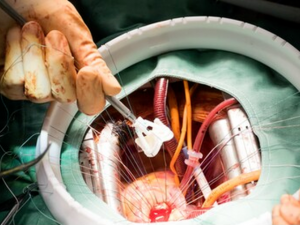Aortic Valve Replacement
Aortic Valve Replacement In Iran
Best aortic valve replacement surgeon in Iran

More than 35.000 Iranian and foreign patients are going under aortic valve replacement hospital in Iran each year. aortic valve replacement in Iran is on top of the middle-east regarding its skilled specialists and surgeons. Here are the best hospitals for aortic valve replacement in Iran:
- Treata Professional Hospital
- Gandi Hospital
- Moheb Mehr Hospital
Aortic valve replacement cost in Iran
There is a significant difference between the cost of aortic valve replacement in Iran and other countries. The most important factors for the low price of it in Iran are:
- A large number of aortic valve replacement hospitals in Iran.
- A large number of applicants for aortic valve replacement in Iran
Aortic valve replacement cost in Iran varies depending on the aortic valve replacement and the hospital. An average cost of aortic valve replacement in Iran is $7,850.
Aortic valve replacement cost in Iran in comparison with other countries
This surgery costs $164,000 in the U.S., $80,000 in Europe, $25,000 in Thailand and $18,000 in Turkey.
Best aortic valve replacement surgeon in Iran
More than 70.000 heart surgeries are being performed each year in Iran. Experienced Iranian doctors with an excellent record are performing the operations. One of the most important factors for choosing a good surgeon for aortic valve replacement in Iran is a doctor has done many aortic valve replacement. You can find the best doctors for aortic valve replacement in Iran on our website by following their different experiences and before- after gallery. Many patients travel to Iran for aortic valve replacement. One of the reasons for this matter is Iranian specialists and surgeons who have high surgery success rates.
- Low cost of aortic valve replacement in Iran
- Low cost of accommodation in Iran
- Well experienced doctors
- The high number of aortic valve replacement in Iran
Aortic valve replacement hospitals accordant with today's European standards are performing the highest quality operations in Iran. Another reason for aortic valve replacement in Iran is its lower cost compared to other countries.
How long should I stay for aortic valve replacement in Iran?
About Aortic Valve Replacement
 The aorta valve surgery may have some risks like any other surgery, but you can reduce the probability of risks if you do this surgery in a hospital equipped with special facilities and an expert medical team. The probable risks without surgery include bleeding, arrhythmia, blood clots, valve dysfunction, stroke and death. The complications of this dysfunction are life-threating so it is essential to take actions immediately.
The aorta valve surgery may have some risks like any other surgery, but you can reduce the probability of risks if you do this surgery in a hospital equipped with special facilities and an expert medical team. The probable risks without surgery include bleeding, arrhythmia, blood clots, valve dysfunction, stroke and death. The complications of this dysfunction are life-threating so it is essential to take actions immediately.
Types of Aortic valve replacement:
- Aortic Valve Replacement
- Aortic Homograft
- Aortic Root Replacement
- Balloon Aortic Valvuloplasty
- Endovascular Stent Graft
- Transcatheter Aortic Valve Replacement (TAVR)
Recommended for
-
patients who suffer from backward flows into the left ventricle instead of only flowing from the ventricle to the aorta
-
patients with narrowed or obstructed aortic valve
-
patients with congenital heart disease
Before Aortic Valve Replacement
Some tests are required before surgery to achieve a clear view of the patient's health. The doctor asks about medical history and allergies. Some medicines should be stopped one week before the surgery. In addition, patients should stop smoking two weeks before the surgery because smoking can cause breathing problems or blood clots. Eating and drinking are forbidden from midnight before the surgery.
During Aortic Valve Replacement
This surgery is usually done in the traditional open-heart method surgery. When the general anaesthesia is achieved after administration of anaesthetic drugs, the surgery is started. The surgeon makes an incision in the chest and opens it, then he or she stops the heart and connect it to a heart-lung machine to circulate the blood. The damaged valve is repaired or replaced with a new one, and at the end, the heart is restarted, and the chest is closed. There is a more modern method to change the aorta valve, which is less invasive and is done via a catheter (a thin tube). This catheter is entered from a small incision in the groin, and the veins reach to the heart. Then a balloon-expandable or self-expandable valve is replaced; this method is called transcatheter aortic valve replacement (TAVR).
Recovery
Patients will spend one night or more in ICU to monitor their heart, lung and body conditions and then moved to a regular room. The number of days that they have to stay in the hospital highly depends on age, the surgery method and the overall health condition. Patients may have pain, redness or swelling around the wound, and they may feel pressure or burn after the surgery. Patients will receive instructions for recovery, such as to walk regularly and gradually increase their activity, and do breathing exercises. They need to follow post-op guidelines to ensure a smooth recovery. They should not drive for four weeks after surgery and not lift heavy weights for four weeks.
